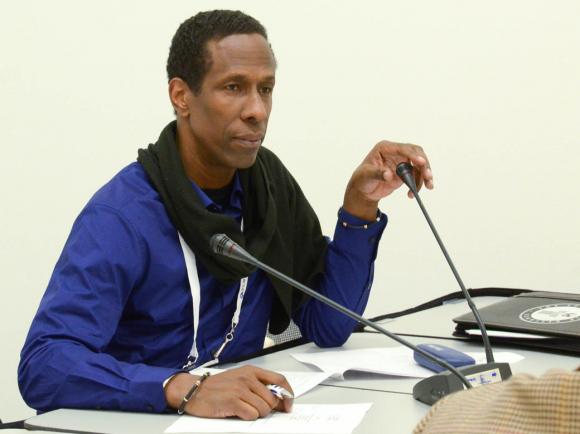PROVIDENCE, R.I. [Brown University] — A new paper in the peer-reviewed journal CBE—Life Sciences Education describes a Brown University program that has significantly improved recruiting and performance of underrepresented minority students in its nine life sciences doctoral programs over the last four years.
Data in the paper show increases in applications, admissions, enrollments, test scores, grades and scientific publications and presentations among underrepresented minority students after implementation of the program called the Initiative to Maximize Student Development (IMSD).
“The pool of really good students is out there and we’re getting them,” said Andrew Campbell, associate professor of medical science in the Department of Molecular Microbiology and Immunology and the paper’s corresponding author.
Peter M. Weber, dean of the Brown Graduate School, praised the success of IMSD, which is funded by a competitive grant from the National Institute for General Medical Sciences. “I’m excited that we can present such encouraging results from an innovative program built by our faculty,” Weber said. “This is a great example of what our broad commitment to creating a more diverse student body at Brown can yield.”

Three-part strategy
Campbell developed IMSD’s three-pronged approach in 2006 and 2007 as director of Brown’s pathobiology Ph.D. program. The strategy was to forge partnerships with undergraduate institutions with high underrepresented minority enrollments, to develop minicourses that build skills needed for doctoral studies, and to involve fellow graduate school faculty members deeply in the partnerships and in training and mentoring admitted students.
The idea’s success in improving student numbers and quality in pathobiology allowed Campbell and co-author Nancy Thompson, professor emerita of medicine, to apply for the NIGMS grant to expand the program to all nine doctoral training programs starting in the 2008-09 academic year. The grant was recently renewed until 2017.
Campbell directs IMSD with Elizabeth Harrington, associate dean for graduate and postdoctoral studies.
Early on, one of Campbell’s insights was that many qualified underrepresented minority students simply might not be aware of Brown and would not think to apply. Forging the partnerships with York College, St. John’s University, North Carolina A&T State University and more recently the College of Mount Saint Vincent, which all have high populations of underrepresented minorities in the sciences, encouraged students there to consider Brown. It also allowed Brown professors to analyze their undergraduate curricula with enough understanding to see where students might have gaps in the training needed for doctoral-level studies. Some of this could be addressed with the minicourses designed by IMSD.
Among the courses are modules such as, “Defending Your Research Proposal and Critiquing Those of Others,” and “Beyond the Hypothesis: Experimental Design and Critical Analysis.”
Over the last four years, Campbell notes, students from all ethnic backgrounds have taken advantage of the courses, not just those recruited through IMSD. “All of these program practices aren’t just applicable to underrepresented minority students, he said. “All of these components are useful for all students.”

Diversity Data
The results of program practices are presented in the paper. In 2011-12 the percentage of all newly enrolled life sciences doctoral students who are from underrepresented minority groups was 23 percent, compared to 17 percent in 2007-08, the year before IMSD began outside of pathobiology. The underrepresented minority proportion of new applications and new admissions also rose.
In 2011-12 about one in five Brown life science doctoral students was from an underrepresented minority group, compared about one in 10 nationally. Meanwhile all nine life sciences doctoral programs at Brown enrolled underrepresented minority students in 2011-12. Only five had such enrollments in 2007-08.
“Participants in the IMSD program can achieve just as much as students who don’t participate in the program,” Campbell said. “It’s not by changing academic expectations but by providing what I call the appropriate training scaffolds.”
The academic qualifications and performance of underrepresented minority students has been rising since implementation of the IMSD, the data in the paper show. The mean undergraduate grade point averages and graduate readiness examination scores of newly enrolled underrepresented minority students all rose to varying degrees between 2007-08 and 2011-12. Campbell and Thompson also counted scientific publications and presentations by underrepresented minority students during 2005-07 and 2008-11 and found statistically significant increases over time. Fellowship awards and travel awards to students also increased in absolute terms but not with statistical significance.
Meanwhile, dozens of faculty members have collaborated on the work of the IMSD program.
“This really says something about the work that our faculty [in the life science programs] have done,” Campbell said.
In the paper, Thompson and Campbell conclude that graduate programs at other institutions can do this, too. “The practices described here are generalizable and can be expected to lead to similar outcomes when applied elsewhere,” they wrote. “As a result, we look forward to seeing measurable advances in the representation of racial, ethnic, and other disadvantaged individuals in the scientific workforce.”
The NIGMS grants supporting the IMSD are 1R25GM083270 and 1R25GM083270-S1.

